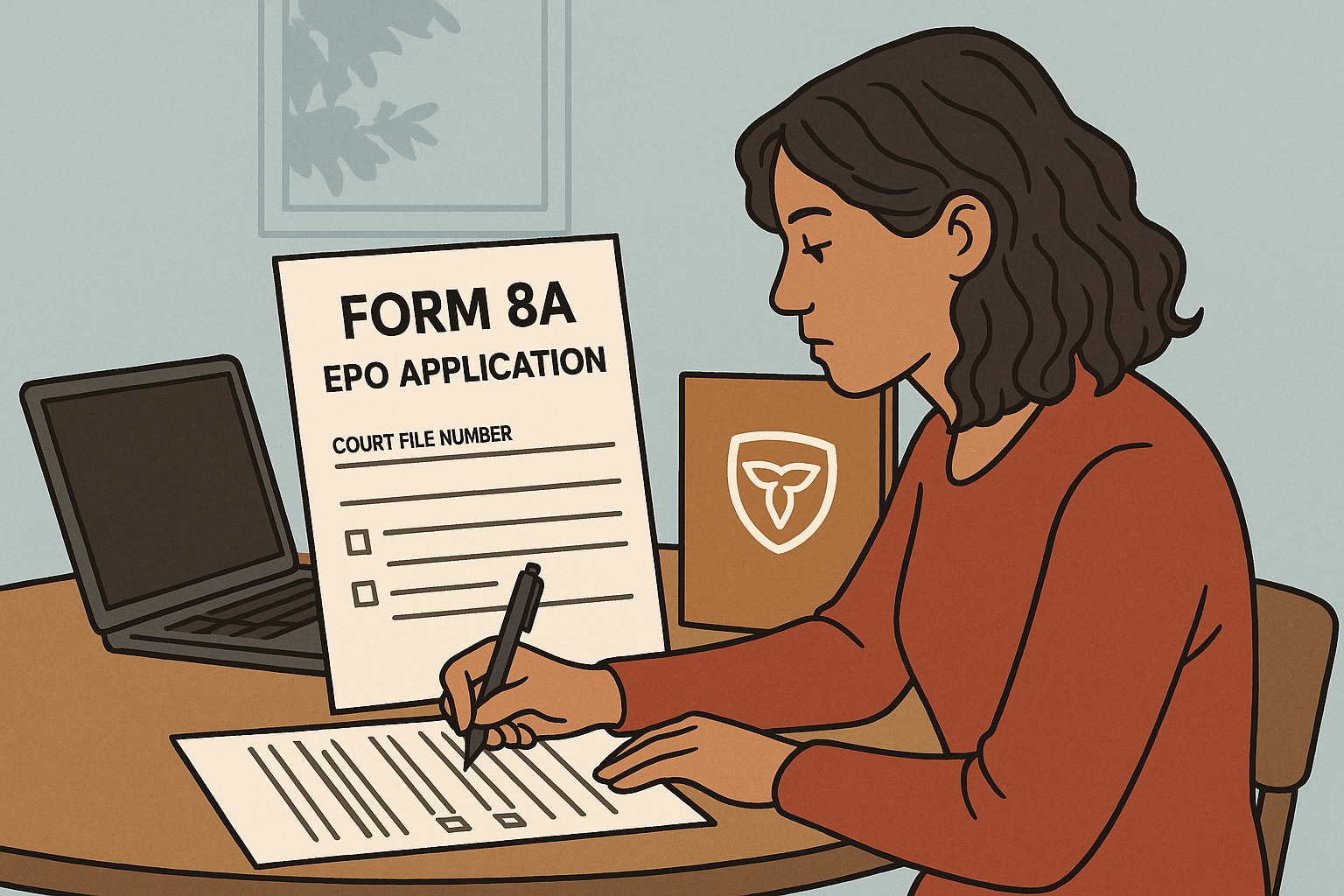EPO Application in Ontario: How to File Form 8A for Emergency Protection
Need urgent legal protection from domestic violence or threats? Learn how to apply for an Emergency Protection Order in Ontario using Form 8A, who qualifies, and how fast it takes effect.

🚨 EPO Application in Ontario: How to File Form 8A for Emergency Protection
When there is an immediate threat of domestic violence, harassment, or stalking, waiting weeks for a standard restraining order can be too long. In urgent situations, Ontario law provides the Emergency Protection Order (EPO), a swift, temporary remedy you can request using Form 8A. This comprehensive guide explains what an EPO is, who qualifies, and step-by-step instructions for filing Form 8A to secure your safety.
What Is an Emergency Protection Order (EPO)?
An EPO is a temporary court order issued on an ex parte (without notice to the other party) basis when there is an imminent risk of harm. Unlike regular family court orders, an EPO can:
-
Restrict contact and communication
-
Exclude the respondent from the family home
-
Prohibit the respondent from coming within a specified distance of you, your children, or your property
-
Remain in effect for up to 90 days, until a full hearing
Who Can Apply for an EPO?
You may apply if you face:
-
Family violence by a spouse, ex-partner, parent, or someone you previously lived with
-
Harassment or stalking that puts you in immediate danger
-
Risk to the safety of your children
For non-family threats, consider a non-family restraining order under Form 9C instead.
Legal Form: Form 8A – Application (General)
-
Purpose: To request emergency or interim protection in family law matters.
-
Download PDF: Form 8A – Application (General)
Supporting Documents
-
Form 35.1 – Affidavit (Children) if child-related relief is sought
-
Form 6B – Affidavit of Service to confirm the respondent has been served
Step-by-Step: Filing Form 8A for an EPO
-
Complete Form 8A
-
Clearly state facts demonstrating imminent risk (dates, incidents, threats).
-
Identify the interim relief needed (e.g., no-contact, exclusive possession).
-
-
File at Your Local Family Court
-
In person or via the Ontario Family E-Filing Service.
-
Indicate that you’re requesting an urgent ex parte hearing.
-
-
Obtain the Ex Parte Order
- A judge may grant the EPO immediately, without the respondent present.
-
Serve the Order on the Respondent
-
Use Form 6B for proof of personal or substituted service.
-
Serve quickly—service is required before a return hearing.
-
-
Attend the Return Hearing
-
Scheduled within days or weeks to determine longer-term orders.
-
Bring any additional evidence and witnesses.
-
Duration and Next Steps
-
Effectiveness: Takes effect as soon as served.
-
Duration: Valid for up to 90 days; the judge may renew or replace with a final order.
-
Follow-Up: Prepare for the return hearing by gathering further documentation and legal representation.
Resources for Legal Support
-
Legal Aid Ontario: 1‑800‑668‑8258 for certificate-based representation
-
Family Law Information Centres (FLIC): Free on-site guidance in many courthouses
-
Community Legal Clinics: Local family law advice and summary services
-
Local Women’s Shelters: May assist with paperwork and safety planning
Frequently Asked Questions (FAQs)
1. What is an Emergency Protection Order (EPO)?
An EPO is a temporary, urgent court order made under the Family Law Act to provide immediate protection to a person or their children who are at risk of harm from a family member. It can be granted "ex parte" (without the other person present) to ensure immediate safety.
2. How long does an Emergency Protection Order last?
A temporary EPO is short-term. It remains in effect until the "return hearing," where a judge will decide whether to make a more long-term order. The initial order can last up to 90 days, but the return hearing is typically scheduled much sooner.
3. What kind of protection can I get with an EPO using Form 8A?
You can ask for several types of urgent protection, including an order that grants you exclusive possession of the matrimonial home (meaning your partner must leave), a restraining order preventing any contact, or an order preventing your partner from selling or hiding family assets.
4. What is the difference between an EPO and a restraining order?
An EPO is a very specific type of urgent, temporary restraining order granted under the Family Law Act. It's the first step in an emergency. At the follow-up hearing, this temporary order can be converted into a standard, longer-term restraining order.
5. Do I need a lawyer to file Form 8A for an emergency order?
While it is highly recommended to get legal advice, especially in a crisis, the system is designed so that you can file for an EPO on your own. You can get help from duty counsel at the courthouse or from a local women's shelter.
6. What is the most important thing to remember when filing for an EPO?
The most important thing is to clearly communicate the urgency and the risk of harm. You must provide enough factual detail in your application to convince a judge that immediate protection is necessary for your safety or the safety of your children.
